La Perspectiua, y Especularia de Euclides. Traduzidas en vulgar castellano, y dirigidas a la S.C.R.M. del Rey don Phelippe nuestro señor. Por Pedro Ambrosio Onderiz su criado by Euclid of Alexandria (323–283 BC) - 1585
by Euclid of Alexandria (323–283 BC)

La Perspectiua, y Especularia de Euclides. Traduzidas en vulgar castellano, y dirigidas a la S.C.R.M. del Rey don Phelippe nuestro señor. Por Pedro Ambrosio Onderiz su criado
by Euclid of Alexandria (323–283 BC)
- Used
- good
- first
[4] (of [6]), 57 (of 60) leaves (with 3 facsimile leaves at end). ii6 (-ll2-3?), A-P4 (-P2-4) with illustrations throughout. Small octavo (7 1/4" x 5 3/4"), bound in period vellum, later end-papers.
The first translation into Spanish of Optics and Catoptrics. "Optica" is ascribed to Euclid; the 'Catoptrica' ('Reflections') is not by Euclid but is, rather, a later compilation from ancient works on the subject. "Optica et Catoptrica" is the earliest surviving Greek work on perspective, and until the arrival of Newton's Opticks, the most important. The translator of the present work, Pedro Ambrosio Onderiz, was appointed by King Philip II to a chair in the newly established Academia de Matemáticas, and was expressly charged with the translation of scientific works into Spanish. The only earlier work by Euclid that had been translated into Spanish was the 1576 Los seis libros primeros de la geometria; prior to that, the only printing of Euclid in Spain was a truncated Mathematicae quaedam selectae, done in 1566.
Euclid, sometimes called Euclid of Alexandria to distinguish him from Euclid of Megara, was a Greek mathematician, often referred to as the "founder of geometry" or the "father of geometry". He was active in Alexandria during the reign of Ptolemy I (323–283 BC). His Elements is one of the most influential works in the history of mathematics, serving as the main textbook for teaching mathematics (especially geometry) from the time of its publication until the late 19th or early 20th century. In the Elements, Euclid deduced the theorems of what is now called Euclidean geometry from a small set of axioms. Euclid also wrote works on perspective, conic sections, spherical geometry, number theory, and mathematical rigor. Very few original references to Euclid survive, so little is known about his life. He is mentioned by name, though rarely, by other Greek mathematicians from Archimedes (c287 BC-c212 BC) onward, and is usually referred to as "ὁ στοιχειώτης" ("the author of Elements"). The few historical references to Euclid were written by Proclus c450 AD, centuries after Euclid lived.
Although many of the results in Elements originated with earlier mathematicians, one of Euclid's accomplishments was to present them in a single, logically coherent framework, making it easy to use and easy to reference, including a system of rigorous mathematical proofs that remains the basis of mathematics 23 centuries later. There is no mention of Euclid in the earliest remaining copies of the Elements. Most of the copies say they are "from the edition of Theon" or the "lectures of Theon", while the text considered to be primary, held by the Vatican, mentions no author. Proclus provides the only reference ascribing the Elements to Euclid. Although best known for its geometric results, the Elements also includes number theory. It considers the connection between perfect numbers and Mersenne primes (known as the Euclid–Euler theorem), the infinitude of prime numbers, Euclid's lemma on factorization (which leads to the fundamental theorem of arithmetic on uniqueness of prime factorizations), and the Euclidean algorithm for finding the greatest common divisor of two numbers. The geometrical system described in the Elements was long known simply as geometry, and was considered to be the only geometry possible. Today, however, that system is often referred to as Euclidean geometry to distinguish it from other so-called non-Euclidean geometries discovered in the 19th century.
Condition:
Some soiling and wear to vellum; title page backed with paper restoring some marginal chipping, a number of leaves with archival repairs to worming in gutter margins or to loss at upper corners and a few other places, some minor staining; good condition, with respectable restoration.
-
Bookseller
The Book Collector ABAA, ILAB, TBA
(US)
- Book Condition Used - Good
- Quantity Available 1
- Edition First
- Publisher En casa de la viuda de Alonso Gomez
- Place of Publication Madrid
- Date Published 1585
- Pages [4] (of [6]), 57 (of 60) leaves (with 3 facsimile leaves at end). ii6 (-ll2-3?), A-P4 (-P2-4) with illustrations throughout.
- Size Small octavo
- Size Small octavo

Pirotechnia. Li diece libri della pirotechnia, nelli quail si tratta non solo la diversita delle minere, ma ancho quanto si ricera alla prattica di esse: e di quanto s'appartiene all'arte della fusiione ouer getto de metallic, e d'ogni altra cosa a Questa
by BIRINGUCCIO, Vannoccio
- Used
- Hardcover
- first
- Condition
- Used - See Description
- Binding
- Hardcover
- Quantity Available
- 1
- Seller
-
Concord, Massachusetts, United States
- Item Price
-
$5,500.00
Show Details
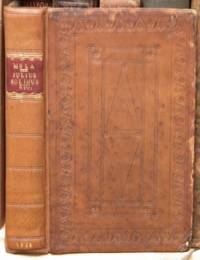
Pomponius Mela. Iulius Solinus. Itinerarium Antonini Aug. Vibius Sequester. P. Victor de regionibus urbis Romae. Dionysius Afer de situ orbi, Prisciano Interpret
by MELA, Pomponius Et Al
- Used
- first
- Condition
- Used
- Edition
- 1st Edition
- Binding
- Unknown
- Quantity Available
- 1
- Seller
-
Toronto, Ontario, Canada
- Item Price
-
$5,494.50
Show Details

Theologia naturalis; sive, Liber creaturarum specialiter de homine et de natura ejus in quantum homo: et de his que sunt ei necessaria ad cognoscendum seipsum et Deum, et omne debitum ad quod homo tenetur et obligatur tam Deo quam proximo.
by De Sabunde, Raymundus (Raimundus Sabundus, Raymond of Sebonde or Ramon Sibiuda, Catalan scholar, c.1385-1436)
- Used
- Fine
- Hardcover
- Condition
- Used - Fine
- Binding
- Hardcover
- Quantity Available
- 1
- Seller
-
Worcester, United Kingdom
- Item Price
-
$4,982.92
Show Details

Carcer d’amore traducto dal magnifico Miser Lelio de Manfredi ferrarese: de idioma spagnolo in lingua materna: novamente stampato
by [San Pedro Diego Fernandez de (ca. 1437 – ca. 1498)]
- Used
- Condition
- Used - Very Good+
- Quantity Available
- 1
- Seller
-
Milan, Italy
- Item Price
-
$5,925.15
Show Details
![[The first Italian food and wine guide] Commentario de le più notabili et mostruose cose...](https://d3525k1ryd2155.cloudfront.net/h/445/783/1453783445.0.m.0.jpg)
[The first Italian food and wine guide] Commentario de le più notabili et mostruose cose d’Italia et altri luoghi, di lingua Aramea in Italiana tradotto. Con un breve catalogo de gli inventori de le cose che si mangiano et beveno, novamente ritrovato
by [Lando Ortensio (Milano, ca. 1512-Venezia, 1553)]
- Used
- very good
- Condition
- Used - Very Good
- Quantity Available
- 1
- Seller
-
Milan, Italy
- Item Price
-
$5,386.50
Show Details
Provenienza: al frontespizio, antiche annotazioni manoscritte e nota di possesso; Collezione Maria Paola Moroni Salvatori.
Rarissima terza edizione (la princeps, priva di dati tipografici: Venezia 1548). Paleari Hensselr, 414. B.IN.G., 1080.
Il Commentario del Lando - tra i più geniali poligrafi rinascimentali, traduttore in italiano dell'Utopia di Tommaso Moro (1548) - è inoltre assai celebre in quanto alcune sue pagine "illustrano un ideale itinerario gastronomico per le città d'Italia, con riferimento a cibi e vini di cui l'autore mostra di aver acquisito conoscenze di prima mano" (L'arte della cucina in Italia, a cura di E. Faccioli, Torino 1992, p. 275).
"Questo testo costituisce un catalogo etnico-socio-gastronomico estremamente eterogeneo, inserito in un itinerario quasi iniziatico che si snoda attraverso la… Read More

Opera Ex Petri Victorii codicibus maxima…
by CICERO, M[arcus] T[ullius]
- Used
- Hardcover
- Condition
- Used
- Binding
- Hardcover
- Quantity Available
- 1
- Seller
-
Toronto, Ontario, Canada
- Item Price
-
$4,995.00
Show Details

GESCHLECHTER BUCH: Darinn der Loblichen Kaiserliche Reichs Statt AUGSPURG so vor Funffhundert und mehr Jaren hero daselbst gewonet ..
by Mair, Paul Hector [not named here] illustrated by Jost Amman, FM and Christoph Weiditz
- Used
- Hardcover
- Signed
- Condition
- Used - Very Good-
- Binding
- Hardcover
- Quantity Available
- 1
- Seller
-
Blockley, Gloucestershire, United Kingdom
- Item Price
-
$5,298.30
Show Details

Missae episcopales pro sacris ordinibus conferendis: secundum ritu[m] sacrosancte Romane Ecclesie ....
by Machabaeus, Hieronymus.
- Used
- very good
- Hardcover
- Condition
- Used - Very Good
- Binding
- Hardcover
- Quantity Available
- 1
- Seller
-
Tuxedo Park, New York, United States
- Item Price
-
$5,000.00
Show Details

Assertio veteris vulgatae editionis iuxta decretum Sacrosancti oecumenici & generalis Concilij Tridentini Sessione quarta. [Junto con:] Assertionis pro tuenda veteri vulata (sic) latina editione secundum mentem Concil. Trid. & pars secunda.
by RAMOS, Nicolás
- Used
- first
- Condition
- Used
- Edition
- First Edition Primera edición
- Binding
- Unknown
- Quantity Available
- 1
- Seller
-
Madrid, Madrid, Spain
- Item Price
-
$4,309.20
Show Details
![[A miracle on the Camino to Santiago de Compostela] La Rappresentatione d’un miracolo di dua...](https://d3525k1ryd2155.cloudfront.net/h/841/783/1453783841.0.m.0.jpg)
[A miracle on the Camino to Santiago de Compostela] La Rappresentatione d’un miracolo di dua Pellegrini, che andorno a San Iacopo di Galitia. Nuovamente ristampata
- Used
- very good
- Condition
- Used - Very Good
- Quantity Available
- 1
- Seller
-
Milan, Italy
- Item Price
-
$6,463.80
Show Details
Provenienza: Fairfax-Murray ? (cfr. Sander, 6220 [nota]); Libreria Il Polifilo, Milano (Cat. XIII [1947], n. 69).
Rarissima edizione fiorentina, splendidamente illustrata da tre silografie scenico-narrative. Cioni, 175-76; De Batines, 35-36; Sander, 6220 [nota]; Kristeller, 185.
Quella del frontespizio, reimpressa al verso dell'ultima carta, riprende il legno della prima edizione [Firenze, fine del sec. XV- inizi del sec. XVI, cfr. Sander, 6215, tav. 646, De Marinis, 166, tav. CXCVIII). Il secondo legno, che rappresenta un giovane uomo inginocchiato davanti a un… Read More

Opera omnia in usum ivuentutis scholasticae emendate admodum edidit notisque ad modum Ioh. Minellii explicuit et intellectu facillima reddidit M. Christ. Iuncker.
by SALLUSTIUS, Crispus Caius; [Sallust]
- Used
- Hardcover
- Condition
- Used - See Description
- Binding
- Hardcover
- Quantity Available
- 1
- Seller
-
Concord, Massachusetts, United States
- Item Price
-
$125.00
Show Details
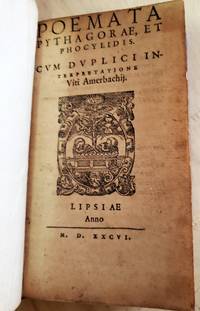
POEMATA PYTHAGORAE, ET PHOCYLIDIS: Cvm Dvplici Interpretatione Viti Amerbachij
by Pythagorae; Pythagoras
- Used
- near fine
- Hardcover
- Condition
- Used - Near Fine
- Edition
- Reprint
- Binding
- Hardcover
- Quantity Available
- 1
- Seller
-
Hopkins, Minnesota, United States
- Item Price
-
$300.00
Show Details
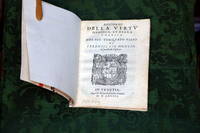
Discorso della virtù heroica, et della charità.as Sig. Monsig. il Cardinale Cesareo.
by Tasso Torquato
- Used
- Condition
- Used - ottimo
- Edition
- prima edizione
- Quantity Available
- 1
- Seller
-
Arezzo, Italy
- Item Price
-
$387.83
Show Details

Sexti Pompei Festi De verborum significatione fragmentum. Ex vetustissimo exemplari Bibliothecae Farnesianae descriptum. Schedae quae Festi fragmento detractae apud Pomponium Laetum extabant. Ex bibliotheca Fulvi Ursini. Notae in Sex. Pompei Festi fragmentum, schedas & epitomam.
by FESTUS & M. VERRIUS FLACCUS
- Used
- Hardcover
- Condition
- Used
- Binding
- Hardcover
- Quantity Available
- 1
- Seller
-
AMSTERDAM, Netherlands
- Item Price
-
$538.65
Show Details
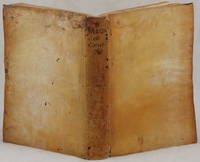
CONSILIA SIVE RESPONSA
by Roberto Maranta
- Used
- Condition
- Used
- Quantity Available
- 1
- Seller
-
Foligno (PG), Italy
- Item Price
-
$538.65
Show Details

CHRISTOPHORI LONGOLII EPISTOLARUM LIBRI IIII TULLIANAE VIDELICET ELOQUENTIAE AD UNGUEM EXPRESSA IMAGO
by Cristophe Longueil
- Used
- Condition
- Used
- Quantity Available
- 1
- Seller
-
Foligno (PG), Italy
- Item Price
-
$538.65
Show Details
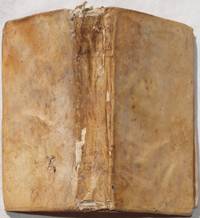
ADRIANUS TT. S. CHRYSOGONI S. R. E. PRESBYTER CARDINALIS DE SERMONE LATINO ET MODIS LATINE LOQUENDI EIUSDEM VENATIO AD ASCANIUM CARDINALEM ITEM ITER IULII II PONTIFICIS ROM.
by Adriano Castellesi
- Used
- Signed
- Condition
- Used
- Quantity Available
- 1
- Seller
-
Foligno (PG), Italy
- Item Price
-
$592.52
Show Details
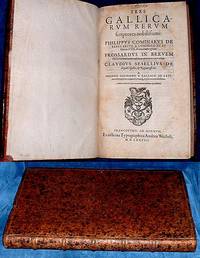
TRES GALLICARUM RERUM scriptores nobilissimi Philippus Cominaeus de rebus gestis a Ludovico XI et Carolo VIII Francorum regibus; Frossardus in brevem historiarum memorabilium epitomen contractus; Claudius Sesellius de republ. Galliae & Regum officiis. A Ioanne Sleidano e Gallico in Latinum sermonem conversi breviq[ue] explicatione illustrati.
by Commynes, Philippe de, Jean Froissart & Claude de Seissel trans. by Johannes Sleidanus (1506-1556)
- Used
- very good
- Hardcover
- first
- Condition
- Used - Very Good
- Binding
- Hardcover
- Quantity Available
- 1
- Seller
-
Blockley, Gloucestershire, United Kingdom
- Item Price
-
$592.91
Show Details

HOMILIAE SIVE CONCIONES PRAESTANTISSIMORUM Ecclesiae Catholicae Doctorum, Primum ab Alcuino Levita iussu Imp. CAROLI MAGNI in hunc redactae ..
by Paulus Diaconus [Paul, the Deacon, ca. 720-799?] and others
- Used
- good
- Hardcover
- Condition
- Used - Good
- Binding
- Hardcover
- Quantity Available
- 1
- Seller
-
Blockley, Gloucestershire, United Kingdom
- Item Price
-
$592.91
Show Details
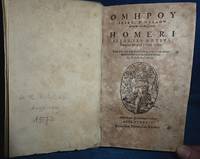
ILIAS, SEU POTIUS, OMNIA EIUS QUAE EXTANT OPERA (preceded by title in Greek, ?�???? ?????, ? �????? ?pa?ta t? s???�e?a). Studio & cura Ob. Giphanii I.C. quam emendatissime edita, cum eiusdem scholijs & indicibus novis.
by Homer
- Used
- good
- Hardcover
- Condition
- Used - Good
- Binding
- Hardcover
- Quantity Available
- 1
- Seller
-
Blockley, Gloucestershire, United Kingdom
- Item Price
-
$604.26




